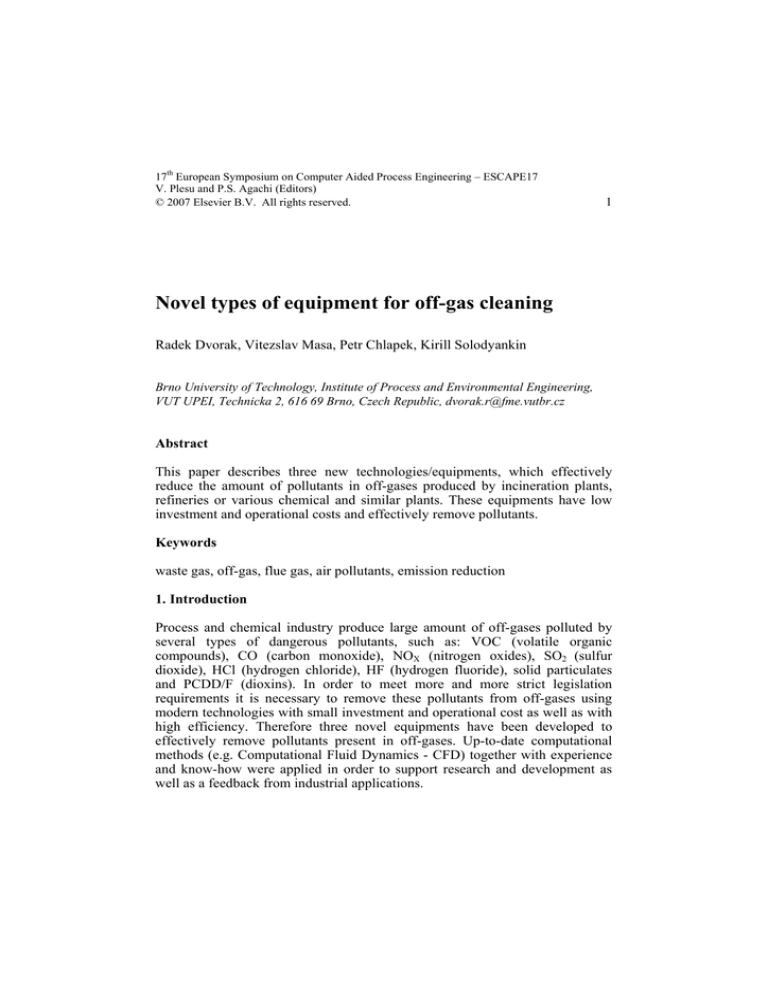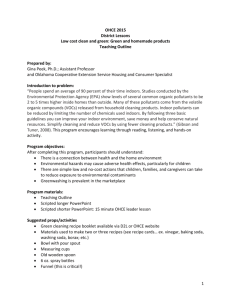
17th European Symposium on Computer Aided Process Engineering – ESCAPE17
V. Plesu and P.S. Agachi (Editors)
© 2007 Elsevier B.V. All rights reserved.
1
Novel types of equipment for off-gas cleaning
Radek Dvorak, Vitezslav Masa, Petr Chlapek, Kirill Solodyankin
Brno University of Technology, Institute of Process and Environmental Engineering,
VUT UPEI, Technicka 2, 616 69 Brno, Czech Republic, dvorak.r@fme.vutbr.cz
Abstract
This paper describes three new technologies/equipments, which effectively
reduce the amount of pollutants in off-gases produced by incineration plants,
refineries or various chemical and similar plants. These equipments have low
investment and operational costs and effectively remove pollutants.
Keywords
waste gas, off-gas, flue gas, air pollutants, emission reduction
1. Introduction
Process and chemical industry produce large amount of off-gases polluted by
several types of dangerous pollutants, such as: VOC (volatile organic
compounds), CO (carbon monoxide), NOX (nitrogen oxides), SO2 (sulfur
dioxide), HCl (hydrogen chloride), HF (hydrogen fluoride), solid particulates
and PCDD/F (dioxins). In order to meet more and more strict legislation
requirements it is necessary to remove these pollutants from off-gases using
modern technologies with small investment and operational cost as well as with
high efficiency. Therefore three novel equipments have been developed to
effectively remove pollutants present in off-gases. Up-to-date computational
methods (e.g. Computational Fluid Dynamics - CFD) together with experience
and know-how were applied in order to support research and development as
well as a feedback from industrial applications.
2
R. Dvorak et al.
2. Novel types of equipment
2.1. Equipment for thermal and catalytic treatment of waste gases polluted by
VOC and carbon monoxide (alternatively NOX)
The equipment in Figure 1 has been designed to remove VOC, carbon
monoxide and NOX [1]. It should be used especially for treatment of small flow
rates of off-gas with a large concentration of the already mentioned pollutants.
For the removal of VOC and carbon monoxide thermal oxidation process with
temperatures in the combustion chamber higher than 600°C or catalytic
oxidation with temperatures between 150 do 350°C are used. For catalytic
oxidation catalysts Pt/Al2O3 or Pd/Al2O3 are used most frequently but others
including Rh, CrO3, CuO, Co2O3 or V2O5 distributed as layers on Al2O3, SiO2,
TiO2 carriers or zeolites can also be used. For the removal of NOX the process
of selective catalytic reduction (SCR) is used i.e. at temperatures between 200
to 250°C flue gas passes through a catalyst bed (usually V2O5/TiO2), where
NOX with NH2-X compounds react (with X = H, CN or CONH2). These
compounds are injected into the flow of flue gas before the equipment.
This equipment helps to process off-gas with a concentration of pollutants from
hundreds of mg/mN3 to units of g/mN3 [2]. For the treatment at lower levels (tens
of mg/mN3) and high flow rates (up to hundreds of thousands mN3/h) it is
advised to combine this equipment with units for concentration of off-gases, i.e.
adsorbtion systems or rotary concentrators.
The equipment consists of three main parts –
cylindrical combustion chamber, catalytic
reactor and coaxial heat exchanger, these parts
are integrated into one equipment. Preheating of
waste gas provides the special heat exchanger,
which consists of several concentric cylindrical
plates. Flue gas from the combustion chamber
(catalytic reactor) and waste gas (which is heated
by flue gas) spiral flow in the spaces between
these plates. Thanks to this solution good
effectivity of heat exchange is achieved.
Thermal/catalytic oxidation of waste gas
proceeds
in
cylindrical
combustion
chamber/catalytic reactor. The combustion
chamber is placed inside the coaxial heat
exchanger in its axial axis and the catalytic
reactor is placed below the combustion chamber.
Therefore the equipment is very compact – the
combustion chamber, catalytic reactor and heat Figure 1 Compact equipment
exchanger are concentrated in small volume.
There are no pipelines needed for connection of combustion chamber, catalytic
Novel types of equipment for off-gas cleaning
3
reactor and heat exchanger in this case. Next advantage of designed
construction is low heat losses. It follows easier achieving of the auto-thermal
regime (it is not necessary to supply next auxiliary fuel into the natural gas
burner), namely at combustion of higher concentration of combustibles
pollutants. Then the auxiliary fuel is used at starting/stopping equipment only or
in time, when the concentration of combustibles pollutants in waste gas is low.
2.2. Equipment for wet cleaning of flue gases polluted by SO2, HCl and HF with
new type of homogenizer “O-element”
The equipment for wet cleaning of flue gases polluted by SO2, HCl and HF with
a new type of a homogenizer “O-element” is an alternative to present
equipments for wet cleaning of flue gases with a traditional homogenizer
“Venturi” [3]. The equipment is suitable especially for incineration plants of
municipal and industrial waste.
In the wet cleaning system liquid absorbent is injected into the flow of flue gas.
The absorbent is usually an alkali solution of lime or NaOH, which reacts with
pollutants dissolving resp. diffusing into the liquid [4]. Transition area is the
most important factor for complete cleaning. Usually the equipment for wet
cleaning of gases has a two levels design. The first level is frequently created by
a homogenizer of “Venturi” or “O-element” type, the second level is created by
a packed column.
The homogenizer “O-element” design has been described in Figure 2, where the
large transition phenomenon is created in the area where both flows meet.
Figure 2 Equipment for wet cleaning of flue gases
The advantage of this equipment is a low pressure drop compared to “Venturi”
type whilst maintaining the same level of wet cleaning. Lower pressure drop
4
R. Dvorak et al.
can notably reduce investment and operation costs for transport of flue gases in
industrial plants.
2.3. Combined experimental equipment for cleaning of waste gases polluted by
solid particulates, SO2, HCl, HF and heavy metals (alternatively NOX or
PCDD/F)
Combined experimental equipment (see Figure 3) has been developed to verify
the technology for cleaning of flue gases in chemical and process industry,
mainly the following processes of flue gases cleaning: filtration/catalytic
filtration of solid particulates and PCDD/F [5], dry cleaning of flue gases – i.e.
reaction of SO2, HCl and HF with injected adsorbent NaHCO3, adsorption of
VOC, heavy metals and PCDD/F on a layer of active carbon [6, 7] and selective
catalytic reduction NOX (SCR).
Developed experimental equipment is designed to
process 1000 m3/h of waste gas (flue gas) at max.
temperature 250°C and will be connected to a process
with a underpressure of about 10 kPa. Maximum
processed levels of pollutants: solid particulates –
2 g/mN3, VOC – 500 mg/mN3, SO2 – 2,000 mg/mN3,
HCl – 1,000 mg/mN3 and HF – 50 mg/mN3.
The design of this experimental equipment is rather
specific. The most important is a mobility feature and
its installation directly at industrial plants. For this
reason, it is a stand alone equipment and apart from
connection to the power line (∼400V/63A) and
standard mains of water, it is completely selfsufficient. From a design point of view, the
experimental equipment has been divided into filter,
replaceable side modules and drive unit.
Filter contains 15 filter bags with a diameter of
152 mm and is 2,500 mm long. Two replaceable
modules are on the each side of the filter. These
modules can be adapted for adsorption process of
waste gas, or for storage of a catalyst for selective Figure 3 Equipment
catalytic reduction NOX (SCR). Area of adsoprtion filtration/adsorption (SCR)
layer is 3.5 m2 and high of the layer is 0.25 m. The last part of the experimental
equipment is so-called drive unit, which will supply transport of waste gas and
pressure gas for pulse-jet regeneration of filter bags. This module also contains
adsorbent injection system (especially for sodium bicarbonate), and can also be
further equipped with a liquid injection system (injection of NH2-X
compounds).
Novel types of equipment for off-gas cleaning
5
The main contribution of an experimental multifunctional equipment is that
individual technologies for off-gas reduction can be tested, modelled, and
optimized directly in operation mode, i.e. without previous laboratory analysis
and scaling-up.
3. Controlling of equipments/processes
To be able to verify the efficiency of these new types of equipments for off-gas
cleaning it was necessary to design experimental pilot unit with a control and
collecting system of the measured data. An example of a controlling combined
experimental equipment for waste gas cleaning is described in 3.1.
3.1. Controlling of combined experimental equipment for cleaning of waste
gases polluted by solid particulates, SO2, HCl, HF and heavy metals
Whole control unit is proposed like a mobile switchboard with PC controlling
of experimental equipment (see Figure 4). Controlling of whole equipment and
record of measured data are accomplished by software „Control Web“. Control
equipment is connected to mains (∼400V/63A). A colour touch monitor is one
component of the control equipment. The filter (3 kW) and individual
components of driving module (like fan (15 kW) and compressor (1,1 kW)) are
connected by means of the control unit. All connections are made as
unmistakable connectors.
Figure 4 Mobile control panel and its screen
Control and collecting system is expandable and is suitable for sensors with
current output 4/20 mA. The basic number of inlets and outlets for control
equipment is BI = 24, BO = 16, AI = 8, AO = 8. The control equipment is able
to display 22 actions and 8 trends at the same time.
6
R. Dvorak et al.
4. Conclusions
Three pilot units for off-gas cleaning with control and collecting system have
been designed. Needed data for design of similar equipments (for industry) were
obtained from experimental tests. The equipment for thermal or catalytic
treatment of waste gas has already been applied in four cases in the chemical
and food industry. Further two equipments are planned to be tested directly in
industry.
Acknowledgements
We gratefully acknowledge financial support of the Ministry of Education,
Youth and Sports of the Czech Republic within the framework of research
project No. MSM 0021630502 "Waste and Biomass Utilization focused on
Environment Protection and Energy Generation" as well as support from the
Czech Science Foundation within project No. 101/05/2469.
References
1.
2.
3.
4.
5.
6.
7.
Stulir R., Stehlik P., Oral J. and Fabikovic V., Fully integrated equipment for thermal
treatment of gas wastes, Applied Thermal Engineering 21 (2001) 1383-1395.
Stehlik P., Stulir R., Bebar L., Oral J., Alternative arrangement of equipment for
thermal processing of wastes from polluted air, Journal of Cleaner Production 12 (2004)
137-146.
Filip M., Buchta J., Bebar L., Stehlik P., New design in off-gas cleaning systems
supported by experimental and computational approach, Proceedings of 8th Conference
on Process Integration, Modelling and Optimisation for Energy Saving - PRES’05, ed J
Klemes, Chemical Engineering Transactions, Volume 7 (2005).
Talaei M.R., Fathikalajahi J., Taheri M., Mathematical Modeling of SO2 Absorption in
a Venturi Scrubber, J. Air & Waste Manage.Assoc. 47 (1997)
1211-1215.
Dr. Peltzoldt, O., Hoke, O., Incineration plants- economic flue gas cleaning by fabric
filters., W.L.Gore & Associates (2005).
Yun, J., Choi, D., Adsorption isotherms of benzene and methylbenzene vapors on
activated carbon, Journal of chemical and Engineering Data, vol. 42, No.5
(1997)
894-896.
Chahbani M.H., Tondeur D., Pressure drop in fixed-bed adsorbers, Chemical
Engineering Journal 81 (2001) 23–34.







